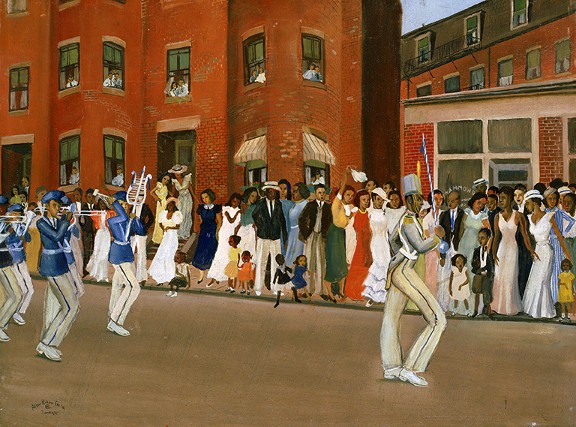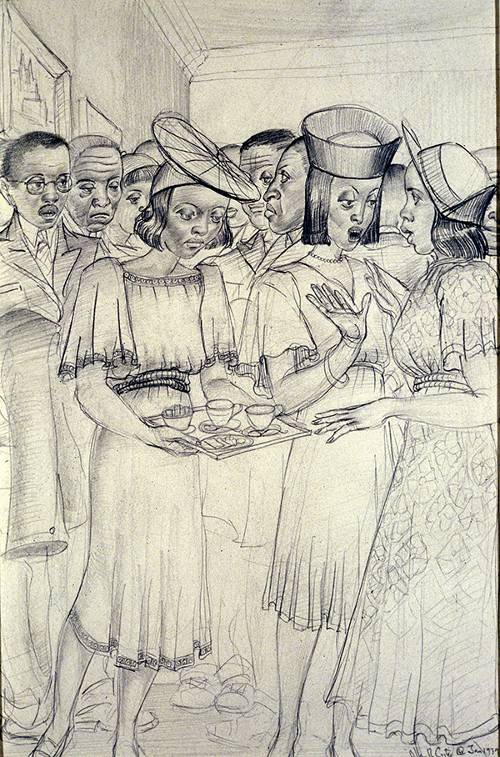March into March: Allan Rohan Crite
As we march into March—and spring—let’s bid a temporary goodbye to Black History Month with a painting by Boston’s own Allan Rohan Crite. I was greatly privileged to meet this lovely, soft-spoken man in Chicago at a Black History Month celebration in the 1980s. I found him to be particularly passionate about one of the foundations of art: drawing.
 |
| Allan Rohan Crite (1910–2007, U.S.), Parade on Hammond Street, 1935. Oil on canvas board, 17 7/8" x 23 7/8" (45.4 x 60.6 cm). Courtesy of The Phillips Collection, Washington, DC. © 2024 Artist or Estate of Artist. (PC-489) |
Like some other artists of his generation, Crite believed that art documenting Black communities could uplift African Americans and give them a sense of pride. The painting, Parade on Hammond Street, chronicles a parade that was part of the Elks fraternal order annual festivities in Lower Roxbury, a predominantly Black community in Boston. It represents the whole neighborhood coming out to celebrate, all dressed in their Sunday clothes.
The unity of the Black neighborhood is reiterated in the unity of the composition. Crite achieved this through the repetition of the figures lining the street, the rhythm of the apartment building windows, and even in the brick patterns on the buildings. The variation in brushwork, particularly in the street, energizes the scene, as does the bright palette.
Born in Plainfield, New Jersey, Crite moved to the Roxbury section of Boston with his family when he was a baby. This was during the period known as the Great Migration (ca. 1910–1970), a time when many Black Americans moved from the rural south to cities in the North, Midwest, and West. A number of vibrant Black neighborhoods were established as a result. Roxbury was the main Black neighborhood of Boston in the 1920s and 1930s. It had a lively artistic and social scene. From an early age, Crite was fascinated by the intellectual activity and social interaction in the community.
Formally trained at the Museum of Fine Arts in Boston, Crite was greatly influenced by 1700s and 1800s realistic paintings of family groups and scenes of everyday middle-class life in the early United States. The painting style he developed was one of realism. Crite painted throughout his life, even during his career as an illustrator for the Boston Naval Shipyards Planning Department.
One of Crite’s wonderful drawings of Roxbury social life:
 |
| Allan Rohan Crite, One of our Exhibitions and Teas, 1939. Pencil on paper, 18 1/8" x 11 13/16" (46 x 30 cm). Private Collection, image courtesy of Los Angeles County Museum of Art exhibition Two Centuries of Black American Art (1976). © 2024 Artist or Estate of Artist. (8S-21918) |
This drawing, One of Our Exhibitions and Teas, depicts one of many social events in Boston in the 1930s. It was an opening for an exhibit of the famous Boston painter, Lois Mailou Jones (1905–1998). The work comes from a series of drawings that were not necessarily meant to be studies for paintings, as they were simple documents of Black life in Boston. The faces are portraits of specific individuals, but the likenesses are achieved with a sparseness of detail. Crite included himself at the extreme left.
Correlations to Davis programs: Explorations in Art 2E Grade 1: 2.5, 5.4; Explorations in Art 2E Grade 2: 2.4, 2.5; Explorations in Art 2E Grade 3: 1.5; Explorations in Art 2E Grade 5: 1.5, 1.7; Experience Art: Units 3 and 7; A Community Connection 2E: 2.1, 7.1; A Personal Journey 2E: 2.1, 2.4; A Global Pursuit 2E: 2.1, 5.1; Discovering Drawing 3E: Chapter 6; Exploring Visual Design 4E: Chapter 12


Comments